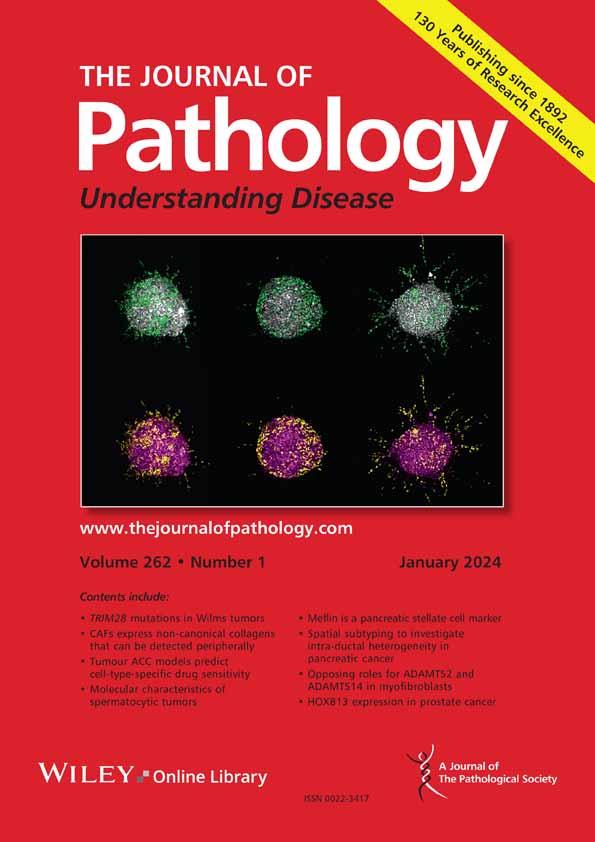Kazuhiro Toriyama, Katsuhiro Masago, Noriko Shibata, Masataka Haneda, Takamichi Kuwahara, Seiji Natsume, Shota Kobayashi, Yasuko Fujita, Eiichi Sasaki, Kenji Yamao, Hiroki Kawashima, Yasuhiro Shimizu, Kazuo Hara, Yasushi Yatabe, Waki Hosoda
下载PDF
{"title":"KRAS野生型胰腺导管腺癌的临床病理和分子特征揭示了RAS通路基因的致癌突变和融合的前驱病变。","authors":"Kazuhiro Toriyama, Katsuhiro Masago, Noriko Shibata, Masataka Haneda, Takamichi Kuwahara, Seiji Natsume, Shota Kobayashi, Yasuko Fujita, Eiichi Sasaki, Kenji Yamao, Hiroki Kawashima, Yasuhiro Shimizu, Kazuo Hara, Yasushi Yatabe, Waki Hosoda","doi":"10.1002/path.6432","DOIUrl":null,"url":null,"abstract":"<p>Pancreatic ductal adenocarcinomas (PDACs) with wild-type <i>KRAS</i> constitute a small fraction of PDACs, and these tumors were recently shown to harbor frequent actionable oncogenic mutations and fusions. However, the clinicopathological features of <i>KRAS</i> wild-type PDAC have not been well studied. Additionally, precancerous lesions occurring in patients with <i>KRAS</i> wild-type PDACs have rarely been characterized. Here, we investigated the clinicopathological characteristics and outcomes of 75 patients with <i>KRAS</i> wild-type PDAC. Molecular analyses were performed in 40 patients using targeted DNA and whole-exome sequencing and targeted RNA sequencing. We demonstrated that patients with metastatic PDAC with wild-type <i>KRAS</i> were younger (median 59.5 years) than those with mutated <i>KRAS</i> (median 67 years, <i>p</i> < 0.000055). The wild-type <i>KRAS</i> status was not a significant prognostic factor for metastatic disease. Molecularly, genes in the RAS pathway are frequently mutated or rearranged (46%, 16/35), including mutations in <i>BRAF</i>, <i>NRAS</i>, <i>HRAS</i>, <i>EGFR</i>, <i>MAP2K1</i>, <i>FGFR1</i>, <i>FGFR3</i> and <i>ERBB4</i> and fusions of <i>FGFR2</i> (<i>FGFR2</i>::<i>CCDC147</i>, <i>FGFR2</i>::<i>CAT</i>, <i>FGFR2</i>::<i>TXLNA</i>), <i>ALK</i> (<i>STRN</i>::<i>ALK</i>, <i>EML4</i>::<i>ALK</i>), and <i>BRAF</i> (<i>TRIP11</i>::<i>BRAF</i>). Mismatch repair deficiency was identified in 10% (4/39) of patients. Potentially actionable alterations were identified frequently in <i>KRAS</i> wild-type PDACs (30%, 12/40), in which nontubular-type carcinomas were significantly enriched with actionable alterations compared with tubular adenocarcinomas [67% (6/9) versus 16% (5/31); <i>p</i> = 0.007]. Finally, we investigated the precursors of PDACs in 13 pancreatectomy specimens from patients with <i>KRAS</i> wild-type PDAC. We identified three pancreatic intraepithelial neoplasias (PanINs) and two intraductal papillary mucinous neoplasms (IPMNs) harboring oncogenic fusions of <i>ALK</i> and <i>BRAF</i> and driver mutations in <i>BRAF</i> and <i>AKT1</i>. This study suggests that in the context of unmutated <i>KRAS</i>, PDAC is driven by alternative oncogenic mutations or fusions of RAS pathway genes, which may be introduced during the early phase of tumorigenesis. © 2025 The Author(s). <i>The Journal of Pathology</i> published by John Wiley & Sons Ltd on behalf of The Pathological Society of Great Britain and Ireland.</p>","PeriodicalId":232,"journal":{"name":"The Journal of Pathology","volume":"266 3","pages":"337-351"},"PeriodicalIF":5.2000,"publicationDate":"2025-05-02","publicationTypes":"Journal Article","fieldsOfStudy":null,"isOpenAccess":false,"openAccessPdf":"https://onlinelibrary.wiley.com/doi/epdf/10.1002/path.6432","citationCount":"0","resultStr":"{\"title\":\"Clinicopathological and molecular characterization of KRAS wild-type pancreatic ductal adenocarcinomas reveals precursor lesions with oncogenic mutations and fusions in RAS pathway genes\",\"authors\":\"Kazuhiro Toriyama, Katsuhiro Masago, Noriko Shibata, Masataka Haneda, Takamichi Kuwahara, Seiji Natsume, Shota Kobayashi, Yasuko Fujita, Eiichi Sasaki, Kenji Yamao, Hiroki Kawashima, Yasuhiro Shimizu, Kazuo Hara, Yasushi Yatabe, Waki Hosoda\",\"doi\":\"10.1002/path.6432\",\"DOIUrl\":null,\"url\":null,\"abstract\":\"<p>Pancreatic ductal adenocarcinomas (PDACs) with wild-type <i>KRAS</i> constitute a small fraction of PDACs, and these tumors were recently shown to harbor frequent actionable oncogenic mutations and fusions. However, the clinicopathological features of <i>KRAS</i> wild-type PDAC have not been well studied. Additionally, precancerous lesions occurring in patients with <i>KRAS</i> wild-type PDACs have rarely been characterized. Here, we investigated the clinicopathological characteristics and outcomes of 75 patients with <i>KRAS</i> wild-type PDAC. Molecular analyses were performed in 40 patients using targeted DNA and whole-exome sequencing and targeted RNA sequencing. We demonstrated that patients with metastatic PDAC with wild-type <i>KRAS</i> were younger (median 59.5 years) than those with mutated <i>KRAS</i> (median 67 years, <i>p</i> < 0.000055). The wild-type <i>KRAS</i> status was not a significant prognostic factor for metastatic disease. Molecularly, genes in the RAS pathway are frequently mutated or rearranged (46%, 16/35), including mutations in <i>BRAF</i>, <i>NRAS</i>, <i>HRAS</i>, <i>EGFR</i>, <i>MAP2K1</i>, <i>FGFR1</i>, <i>FGFR3</i> and <i>ERBB4</i> and fusions of <i>FGFR2</i> (<i>FGFR2</i>::<i>CCDC147</i>, <i>FGFR2</i>::<i>CAT</i>, <i>FGFR2</i>::<i>TXLNA</i>), <i>ALK</i> (<i>STRN</i>::<i>ALK</i>, <i>EML4</i>::<i>ALK</i>), and <i>BRAF</i> (<i>TRIP11</i>::<i>BRAF</i>). Mismatch repair deficiency was identified in 10% (4/39) of patients. Potentially actionable alterations were identified frequently in <i>KRAS</i> wild-type PDACs (30%, 12/40), in which nontubular-type carcinomas were significantly enriched with actionable alterations compared with tubular adenocarcinomas [67% (6/9) versus 16% (5/31); <i>p</i> = 0.007]. Finally, we investigated the precursors of PDACs in 13 pancreatectomy specimens from patients with <i>KRAS</i> wild-type PDAC. We identified three pancreatic intraepithelial neoplasias (PanINs) and two intraductal papillary mucinous neoplasms (IPMNs) harboring oncogenic fusions of <i>ALK</i> and <i>BRAF</i> and driver mutations in <i>BRAF</i> and <i>AKT1</i>. This study suggests that in the context of unmutated <i>KRAS</i>, PDAC is driven by alternative oncogenic mutations or fusions of RAS pathway genes, which may be introduced during the early phase of tumorigenesis. © 2025 The Author(s). <i>The Journal of Pathology</i> published by John Wiley & Sons Ltd on behalf of The Pathological Society of Great Britain and Ireland.</p>\",\"PeriodicalId\":232,\"journal\":{\"name\":\"The Journal of Pathology\",\"volume\":\"266 3\",\"pages\":\"337-351\"},\"PeriodicalIF\":5.2000,\"publicationDate\":\"2025-05-02\",\"publicationTypes\":\"Journal Article\",\"fieldsOfStudy\":null,\"isOpenAccess\":false,\"openAccessPdf\":\"https://onlinelibrary.wiley.com/doi/epdf/10.1002/path.6432\",\"citationCount\":\"0\",\"resultStr\":null,\"platform\":\"Semanticscholar\",\"paperid\":null,\"PeriodicalName\":\"The Journal of Pathology\",\"FirstCategoryId\":\"3\",\"ListUrlMain\":\"https://pathsocjournals.onlinelibrary.wiley.com/doi/10.1002/path.6432\",\"RegionNum\":2,\"RegionCategory\":\"医学\",\"ArticlePicture\":[],\"TitleCN\":null,\"AbstractTextCN\":null,\"PMCID\":null,\"EPubDate\":\"\",\"PubModel\":\"\",\"JCR\":\"Q1\",\"JCRName\":\"ONCOLOGY\",\"Score\":null,\"Total\":0}","platform":"Semanticscholar","paperid":null,"PeriodicalName":"The Journal of Pathology","FirstCategoryId":"3","ListUrlMain":"https://pathsocjournals.onlinelibrary.wiley.com/doi/10.1002/path.6432","RegionNum":2,"RegionCategory":"医学","ArticlePicture":[],"TitleCN":null,"AbstractTextCN":null,"PMCID":null,"EPubDate":"","PubModel":"","JCR":"Q1","JCRName":"ONCOLOGY","Score":null,"Total":0}
引用次数: 0
引用
批量引用





 求助内容:
求助内容: 应助结果提醒方式:
应助结果提醒方式:


